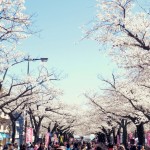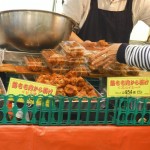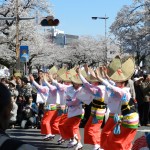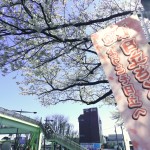An Insider’s Look at Japan: Sakura Matsuri
 In Japanese, “sakura” means cherry blossom. Each year, thousands of sakura trees become awash in white and pink as their little flowers bloom. The trees are planted everywhere: often in parks, but along roads, near shrines, and even along the entire perimeter of a military base in Ibaraki, as well. The resulting explosion of flowers creates an atmosphere of wonder and enchantment across Japan.
In Japanese, “sakura” means cherry blossom. Each year, thousands of sakura trees become awash in white and pink as their little flowers bloom. The trees are planted everywhere: often in parks, but along roads, near shrines, and even along the entire perimeter of a military base in Ibaraki, as well. The resulting explosion of flowers creates an atmosphere of wonder and enchantment across Japan.
In Japanese, “matsuri” means festival. Hitachi City, located in Ibaraki prefecture, annually hosts an event called Sakura Matsuri. The festival takes place along Heiwa Street, which is lined on both sides by tall, thick sakura trees whose branches arch overhead. When the sakura are in full bloom, the effect is magical, and it gives the illusion of walking beneath soft pink-white clouds. Many attendees bring their best cameras and spend time taking scenic pictures of the blossoms and the festivities around them.
 Heiwa Street, usually reserved for cars, crossing pedestrians, and everyday shops, becomes alive with hundreds of visitors. Beneath small white tents, vendors prepare a plethora of foods for passersby to purchase, mostly at reasonable prices. Japanese foods, such as takoyaki (bread balls filled with octopus), okonomiyaki (fried batter mixed with meat and vegetables of the customer’s choice), and yakisoba (friend noodles) can be found alongside French fries, corn dogs, and cotton candy. Some stalls have carnival games for kids and adults to play, with small prizes for the winners. All the way down the street, the air is filled with voices, the scent of food, and occasional billows of smoke from frying meat.
Heiwa Street, usually reserved for cars, crossing pedestrians, and everyday shops, becomes alive with hundreds of visitors. Beneath small white tents, vendors prepare a plethora of foods for passersby to purchase, mostly at reasonable prices. Japanese foods, such as takoyaki (bread balls filled with octopus), okonomiyaki (fried batter mixed with meat and vegetables of the customer’s choice), and yakisoba (friend noodles) can be found alongside French fries, corn dogs, and cotton candy. Some stalls have carnival games for kids and adults to play, with small prizes for the winners. All the way down the street, the air is filled with voices, the scent of food, and occasional billows of smoke from frying meat.
At certain times, sections of the street become host to children’s dance groups. The kids all wear costumes and perform dance numbers for onlookers. Many who stop to watch pull out cameras—parents as well as interested passersby. Younger kids’ groups stick to simple movements, whereas junior-high kids put together more elaborate and impressive dance numbers.
 There’s a lot to do at Sakura Matsuri, especially if it’s your first time attending. You can try new foods, photograph the cherry blossoms, get lost a few times along the streets; lose your group, find your group; wave to any Japanese who call out “Hello!” to you as you pass. Nominate the Japanese speaker in your group to ask for directions when you need them. Chill out at a local café or restaurant, taking a break from the chaos outside while you figure out what to do next.
There’s a lot to do at Sakura Matsuri, especially if it’s your first time attending. You can try new foods, photograph the cherry blossoms, get lost a few times along the streets; lose your group, find your group; wave to any Japanese who call out “Hello!” to you as you pass. Nominate the Japanese speaker in your group to ask for directions when you need them. Chill out at a local café or restaurant, taking a break from the chaos outside while you figure out what to do next.
If you don’t mind walking, or if you have a car, Kamine Park is a mile’s trek from Heiwa Street. It’s full of carnival rides, like a mini-rollercoaster and a Ferris wheel, and it is also full of sakura trees. At night, lanterns strung along the trees are lit, giving the white blooms an etherealness.
 This festival is only one of many that take place all over Japan each year. Some are bigger, and could arguably be better, although there is a definite charm in the local flavor of Hitachi’s celebration. Most of the attendees of Sakura Matsuri are groups of teens or families with small children, all of them spending a happy day together without schedules or obligations. The romanticism of cherry blossom trees is somewhat muted amidst the bustle of people, blaring dance music, and smoky, frying food. On the other hand, it remains a time of honoring tradition while sitting comfortably in the present.
This festival is only one of many that take place all over Japan each year. Some are bigger, and could arguably be better, although there is a definite charm in the local flavor of Hitachi’s celebration. Most of the attendees of Sakura Matsuri are groups of teens or families with small children, all of them spending a happy day together without schedules or obligations. The romanticism of cherry blossom trees is somewhat muted amidst the bustle of people, blaring dance music, and smoky, frying food. On the other hand, it remains a time of honoring tradition while sitting comfortably in the present.
Sakura Matsuri is a time for reflection and appreciation of natural beauty, but it’s also a good reason to get out, have fun, and enjoy another sunny day in Japan.
